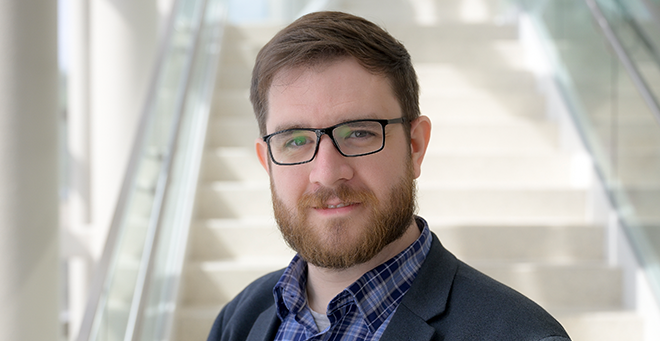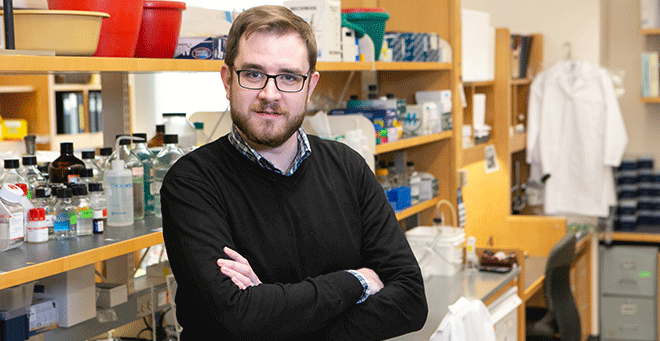
The development of a new technique for building databases that track sequencing of DNA damage caused by chemotherapy and oxygen has earned a UMass Chan Medical School cancer biologist a prestigious National Institutes of Health award celebrating early career investigators.
William Flavahan, PhD, assistant professor of molecular, cell & cancer biology, has been awarded a five-year, $1.5 million NIH Director’s New Innovator Award for creating accessible and affordable databases through the synthesis of “training libraries” to track how DNA is modified and damaged, with potential applications for cancer and neurodegenerative diseases.
“The first aim of the project is building databases to see what DNA damage looks like when run through a third-generation DNA sequencer. This will let us see what’s happening in cancers with oxygen damage and chemotherapy damage as we treat them, tracking exactly what’s happening at the single base level. The second aim is modifying this process so we can also work with RNA,” Dr. Flavahan said.
The project involves procedurally synthesizing short pieces of DNA or RNA, including damaged or altered bases, while adding barcodes during synthesis that identify these bases. When run through a third-generation sequencer, such as a nanopore device, a database of the current values produced by these novel bases can be generated. This method has allowed Flavahan and his lab members to develop these databases significantly cheaper than previous methods and for many more forms of base modifications.
At a glance |
|---|
|
The new approach allows the use of the cell’s genome as a notepad to encode characteristics of the cell, or to reveal modifications made by the cell itself. For instance, Flavahan and his team have sequenced DNA from bacterial-infected human cells to differentiate between human and bacterial DNA based on the unique chemical modifications that bacteria and humans make to their own genomes, and adding chemical tags as the human or bacterial cells divided and grew.
“Human cells and bacterial cells have their own chemical tags. What we did is use these specific chemical marks and, by reading these chemical modifications that each species makes to its own DNA, we could tell whether the DNA was human or bacterial. Since we could find bacterial DNA by chemistry rather than by aligning it to a known bacterial genome, we could pretend we didn’t know this bacteria’s genome and actually recreate it based on the reads that we knew chemically were bacterial DNA,” Flavahan said. “Being able to read the modifications on DNA, instead of just its base sequence, allows for a lot of exciting approaches.”
Ultimately, the multidimensional sequencing experiments performed in this project enhance the understanding of how nucleic acids are modified and damaged within cells and help further develop the technology that allows for continued probing of altered nucleic acid bases, which will be usable by any scientist with a nanopore sequencer.
“One of the best things about this is we’ve built a tool that’s useful to other scientists,” Flavahan said.
The New Innovator Award is one of four NIH Director’s awards and supports early career investigators of exceptional creativity who are proposing bold, highly innovative research. Flavahan is one of 40 recipients of the New Innovator Award this year. The program is part of the High-Risk, High-Reward Research program managed by the Common Fund.
